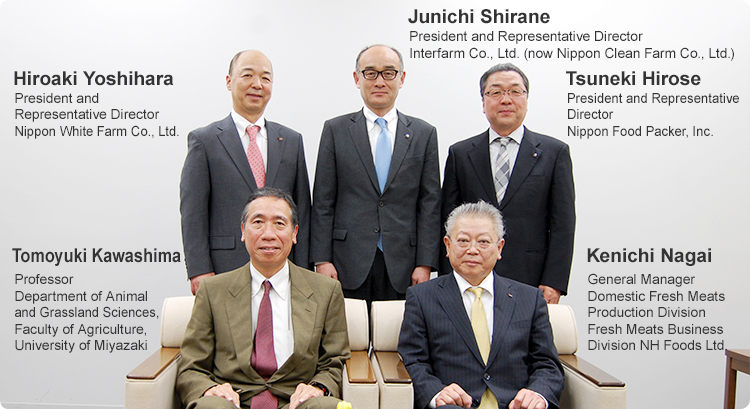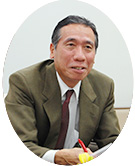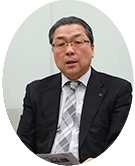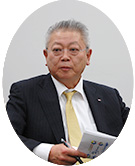The NH Foods Group has selected “sustainable food supply for the next generation” as one of its Five CSR Material Issues* -but how should the Group tackle this issue? In order to explore this question, we invited Tomoyuki Kawashima, professor at the University of Miyazaki’s Faculty of Agriculture, and executives in charge of the NH Foods Group’s domestic fresh meat production to a round-table discussion.
Note: The Five CSR Material Issues have been changed to the Five Materiality (Material Issues) in fiscal 2021.

- Date
- March 14, 2017
- Location
- NH Foods Ltd. Tokyo Branch Office
- Participants
- Tomoyuki Kawashima : Professor
Department of Animal and Grassland Sciences, Faculty of Agriculture, University of Miyazaki
Kenichi Nagai : General Manager
Domestic Fresh Meats Production Division, Fresh Meats Business Division, NH Foods Ltd.
Hiroaki Yoshihara : President and Representative Director
Nippon White Farm Co., Ltd.
Junichi Shirane : President and Representative Director
Interfarm Co., Ltd. (now Nippon Clean Farm Co., Ltd.)
Tsuneki Hirose : President and Representative Director
Nippon Food Packer, Inc. - Facilitator
- Ayako Sonoda:Cre-en Inc
Note: Positions and departments were correct as of the date of the discussion.
Introduction
Securing Feed Supplies to Realize a “Sustainable Food Supply for the Next Generation”
Kawashima: In the livestock industry, feed is of the greatest importance when it comes to realizing a “sustainable food supply for the next generation.” I often ask students in my class: “Why is it that vegetable prices fluctuate according to the weather, but meat prices do not?” The question aims to encourage students to think about how dependent Japan is on overseas supplies of feed, and to understand the hidden side of fresh meat production. Over the last few years, Japan has changed the countries from which it sources its feed; we need to think about feed procurement from a variety of perspectives, including Ecofeed (feed produced from leftover food) and feed rice.
Nagai: We are highly dependent on overseas sources for our feed. This means there is a large risk of price fluctuations, and this leads to business risk. We have tried using Ecofeed in the past; however, we abandoned this initiative as it proved difficult to gather leftover food in regions with small populations. Having said that, if we consider environmental factors, then the use of Ecofeed ought to be a major point of discussion.
Kawashima: It is true that the practicalities of Ecofeed vary greatly between urban and rural areas. The human population is larger than the livestock population in cities, but the opposite is often the case in the countryside, and it is not easy to ensure supplies of leftover food in regions with small populations. In such cases, in addition to leftover food from retailers and restaurants, we must use leftover food generated via crop production and processed food production processes. For example, in regions where they grow potatoes and sweet potatoes, a great deal of produce does not meet standards-we need to come up with a system that makes good use of such food. From a global perspective, Japan is at the forefront of Ecofeed initiatives. I believe that exporting Japan’s Ecofeed technologies to emerging countries with growing livestock industries is also vital for realizing a “sustainable food supply for the next generation.”
Shirane: In order to increase Japan’s feed self-sufficiency rate, we hope to actively utilize feed rice. However, in order to do this, the industry as a whole has to consider a stockpiling system that takes into account the seasonality of crops.
Kawashima: Advances have been made in selective breeding techniques for rice over the last few years. In addition, the effects of global warming mean that double-cropping is now possible in a wider area. In view of these circumstances, it is vital we utilize abandoned farmlands to grow feed rice.
Previously, at a university lecture, we discussed what Japan’s options were if-due to a major drought, for example-we could no longer procure feed from overseas. There were a variety of proposals, ranging from planting and increasing production of feed rice, to producing soy beans and potatoes, and the early shipments of livestock. Such discussions regarding risk management are rarely held in Japan, but there is no guarantee that we will not find ourselves in such a position. It is therefore crucial that we carry out simulations.

Professor
Department of Animal and Grassland Sciences, Faculty of Agriculture, University of Miyazaki
Developing Human Resources
Striking a Balance between Mechanization and Transmission of Techniques
Shirane: Our company is involved in the production of hogs. We utilize flushing robots to clean sties in order to save energy. The robots are capable of doing between 60 and 70 percent of the cleaning work, with human employees responsible for the finishing. This not only reduces work volumes for our employees, but also allows us to reduce water consumption.
Yoshihara: Mechanizing livestock sites can be difficult, but we want to advance our mechanization initiatives in order to reduce workloads. However, there is a problem: the further mechanization progresses, the more difficult it becomes to transmit techniques. For this reason, it is important to ensure that we take into account both sides of the equation: mechanization, and the transmission of techniques.
Our company is involved in poultry production and processing. The first thing we do with new recruits is teach them how to process a single chicken. Our goal is to enable new recruits to acquire the necessary techniques over a single month’s training, since we believe that developing the ability to do something new after joining the company will give them confidence. I would like to encourage the transmission of techniques and develop human resources by providing new recruits with goal-oriented experiences.

President and Representative Director
Nippon White Farm Co., Ltd.
The Twin Challenges of Labor Shortages and Human Resources Development
Yoshihara: In our production and breeding facilities, we are facing two major challenges: a lack of employees, and the difficulty of developing human resources that are capable of sustaining the livestock industry in the future. As a result, we must increase productivity and improve our technologies. At Nippon White Farm, we use our expertise in farm management to carry out cleaning work in the poultry houses of our contract farmers as a way of reducing their workloads. This results in faster turnarounds at the farms, which leads to increased efficiency in poultry production. Our goal is to realize stable procurement by working together with our contract farmers.
Hirose: Our company engages in beef and pork processing. We send experienced staff, known as “meisters,” to local agricultural high schools where they provide instruction on various techniques, such as how to process different cuts of pork. Since students regularly see pork packaged in tray packs, their interest is extremely high. Going forward, we would like to collaborate with high schools and universities to develop human resources capable of sustaining the livestock industry of the future.

President and Representative Director
Nippon Food Packer, Inc.
Kawashima: I hope that students who specialize in livestock breeding are able to fully demonstrate what they have learnt and support the livestock industry. A large number of students who enroll at our university have a strong desire to study livestock breeding in Miyazaki. There are even university clubs that breed, cut and process hogs, and turn them into meat. Carefully nurturing motivated students such as these as well will help sustain future food supplies. For this reason, I would like to see universities and companies working together to improve human resources development.
Meanwhile, it is a fact that the number of farmers in rural areas is decreasing even in emerging nations. Human resources development is therefore a major issue in emerging nations as well. I understand that foreigners are employed at NH Foods Group farms; going forward, I think it is likely that the number of foreigners will increase. Some of these human resources will return to and work in their homelands, and this will lead to improvements in livestock breeding techniques in their countries. In this way, I have high hopes that the NH Foods Group will contribute to human resources development and technological growth in livestock industries not just in Japan, but across the world.
Eliciting the Understanding and Cooperation of Local Communities
Seeking to Generate Profits together with Local Farmers
Shirane: Our company combines hog excrement with straw provided by local farmers to produce compost and fertilizer, and then gives this back to local farmers. By working together with local communities-such as by recycling waste-we hope to contribute to the sustainable growth of the livestock industry.
Hirose: Commercial farmers who want to contribute to local agriculture actively use feed rice and Ecofeed. It is essential that we promote cattle and hogs purchased from such farmers to the wider world. This will encourage cyclical agriculture, and help grow not only the livestock industry but also the wider agriculture industry as a whole. If the entire industry can work together, then the possibilities will increase.
Shirane:We operate a system whereby we entrust the breeding of hogs and poultry to local farmers. This eliminates the risk of changing market prices for the feed and hogs and poultry they ship, and enables farmers to earn a stable income. At the same time, this system ensures that we are able to secure a stable supply of hogs and poultry. Going forward, we intend to continue working together with local farmers.

President and Representative Director
Interfarm Co., Ltd. (now Nippon Clean Farm Co., Ltd.)
The Key to Preventing Epidemics is Information Sharing
Nagai: We share a variety of information with local farmers, including optimal breeding environments, how to deal with problems of day-old and month-old animals, and information regarding epidemics and vaccines. If a nearby farm encounters some sort of trouble, for example, then information is quickly shared. We intend to further raise the level of farming in the region as a whole.
Yoshihara: For anti-epidemic measures in particular, an initial response based on information sharing and regional cooperation is key. Going forward, we will collaborate with the government and local communities in as timely a manner as possible.

Domestic Fresh Meats Production Division
Fresh Meats Business Division
NH Foods Ltd.
Future Initiatives
What is Expected of the NH Foods Group
Kawashima: It is also important that we consider the relationship between livestock breeding and the environment-this is something companies are liable to lose sight of if they focus too much on efficiency gains or on making food as tasty as possible. The Food and Agriculture Organization of the United Nations (FAO) announced that approximately 14.5 percent of global greenhouse gases stem from livestock breeding, and debates are ongoing regarding how to reduce these emissions. I would like the NH Foods Group to proactively reduce its greenhouse gas emissions as well. I would also like to see the NH Foods Group leverage its unique strengths to engage in initiatives-such as acquiring JGAP* certification-aimed at securing a “sustainable food supply for the next generation.”
Nagai: In my opinion, increasing the productivity of livestock products is also a means of reducing greenhouse gas emissions. I would like to see us share our views internally on the relationship between the livestock industry and the environment, and take action accordingly.
Building on today’s discussion, we will leverage the NH Foods Group’s strengths to realize a “sustainable food supply for the next generation” from a global viewpoint.
Note: JGAP: An acronym of “Japan Good Agricultural Practice.” It is a system that evaluates and certifies farms engaging in the production of safe food and environmental conservation based on third party inspection.
